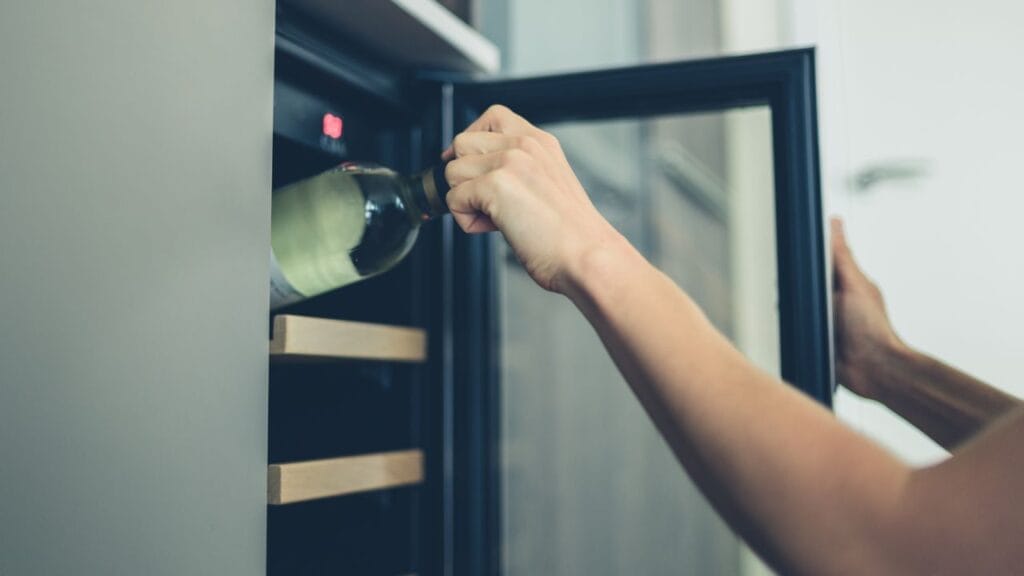Getting a wine fridge is an amazing first step to preserving and perfecting your wine collection.
However, even once you’ve purchased the fridge, you need to set it to the right temperature to keep your wine at its absolute best!
This can be very tricky to work out as different wines have different needs, and different fridges vary in temperature control as well. Don’t worry, though – it’s not too hard to figure out once you know how!
In this article, I’ll walk you through everything you need to know about setting the perfect temperature in your wine fridge, including:
- Understanding different wines and their ideal temperatures
- A step-by-step guide to setting up your wine fridge
- The effects of humidity and light on wine.
Let’s get straight to it!

Understanding Wine and Temperature
Having your wine at the correct temperature is very important both when storing and serving.
Serving wine at the correct temperature simply allows it to taste the best!
In general, red wines should be served at around 12˚C – 18˚C (53 – 60°F) or roughly room temperature, white wine should be served at 8˚C – 12˚C (46 – 53°F), or chilled, and dessert and sparkling wines should be served at 5˚C – 7˚C (41 – 45°F).
Storing wine at the correct temperature is imperative to keep it preserved and aging well.
If it’s any hotter than 70°F, the wine may age too quickly – ruining its taste. If it’s too cold, the wine may not age optimally and the cork can also dry out – potentially risking the seal.
More than anything, it’s important to keep your wine stored at a consistent temperature as fluctuation can have a negative impact on taste and longevity!
Ideal Temperatures for Different Wines

So, what is the ideal storage temperature for wines? Well, much like when serving, different wines like different temperatures for storage as well.
If you’re planning to drink your wines within six months of purchase, you don’t need to worry too much about long-term aging and can follow this:
| Wine Type | Storage Temperature |
| Light, dry white wines and sparkling wine | 40 – 50°F |
| Full-bodied white wines and light fruity red wines | 50 – 60°F |
| Full-bodied red wines and port wine | 60 – 65 °F |
However, if you are planning on aging your wines or just want more precise storage temperatures, read on!
Red Wines: The Warm Souls
Red wines have higher tannin levels and a more complex structure, which means they keep and age better in slightly warmer temperatures.
Here’s a rundown of the perfect storage temperatures for some common reds:
| Wine Type | Storage Temperature |
| Beaujolais | 48-52°F |
| Tawny Port (chilled) – | 50-54°F |
| Côtes du Rhône | 53-56°F |
| Chianti, Sangiovese, Barbera | 56-58°F |
| Young Bordeaux, Young Cab | 58-61°F |
| Merlot, Light Zinfandel | 58-62°F |
| Tawny Port | 59-62°F |
| Red Burgundy, Pinot Noir Chianti Riserva, Barolo, Merlot (oak-aged) | 61-63°F |
| Grand Cru Bordeaux, Mature California Cab, Mature Rhone, Zinfandel, Vintage Port | 61-64°F |
White and Rosé Wines: The Cooler Bunch
White wines and rosés need to be stored at slightly cooler temperatures to slow down their aging process while keeping them warm enough so that their flavors don’t become muted.
Here’s a rundown of the ideal storage temperatures for some popular white wines:
| Wine Type | Storage Temperature |
| Eiswein, Sweet Vouvray | 42-44°F |
| Crémant, non-vintage Classic Rosé, White Zinfandel | 42-45°F |
| Muscat New World, Riesling Gewürztraminer, Loire Valley Whites (Sancerre), Sauvignon Blanc, Alsace Riesling, Italian Whites | 43-46°F |
| Nouveau French Chablis, Chardonnay, White Burgundy, Viognier, Condrieu | 48-52°F |
| Full-Bodied Chardonnay | 50-54°F |
| Côtes du Rhône | 53-56°F |
Sparkling Wines and Champagne: The Cold Dwellers
Sparkling wines need to be kept the coldest to slow down the release of carbon dioxide. If they’re too warm, they’ll lose their fizz!
However, you don’t need to keep them ice cold. Generally, sweet sparkling wines should be kept at around 39-43°F, Vintage sparkling wines at 43-46°F, and Champagnes at 48-53° F.
Setting Up Your Wine Fridge: Step-by-Step

The exact method of setting up your wine will vary depending on the make and model, but here are a few basics to have in mind:
- Pick the Right Spot. You’ll need an area that has adequate space for your fridge, is level, and has access to a power source.
Additionally, it’s important that it is not in direct sunlight or close to any heating units, as this can disrupt the function of the fridge and the preservation of your wine
- Install the Fridge. Follow the manufacturer’s instructions to install the fridge. Make sure it is sitting level and has room for both ventilation and for the door to open
- Wait. Give your fridge some time before turning it on so that the coolant can settle!
A couple of hours will probably be fine, but leave it a little longer if it is a bigger unit or if it was transported lying on its side.
- Set the Temperature. Depending on what kind of wine you’re storing, set the temperature of your fridge. Some fridges are dual-zone or multi-zone, meaning you can set different temperatures for different regions of the fridge. Many people opt to have different zones for white and red wines, or one zone for storage and one for right before serving
- Put In Your Wine. It’s the moment you’ve been waiting for: showing your bottles to their new home!
Make sure to place them in the correct zones if you have a dual or multi-zoned fridge. It’s also important not to overload your unit, as if it’s too full it can prevent proper temperature regulation and circulation of air
- Leave it Alone. As much as possible, don’t alter the temperature of the fridge once you’ve set it unless you’ve finished the stored wine!
Also try to avoid keeping the door open for long periods or doing anything else that disrupts the consistency of the fridge’s internal temperature.
- Enjoy! You’ve now got perfectly stored wine at your fingertips – so why not open a bottle to celebrate?
While it’s important to leave your wine undisrupted as much as possible, that doesn’t mean you should neglect routine maintenance of your wine fridge!
You should clean your fridge every six months to a year (keeping your bottles in a dark, cool place while you do so), and make sure there is no build-up of frost or moisture.
Some fridges also use carbon filtration systems to prevent odors from seeping into your wines. If this is the case with your fridge, you should also change the filter every three to six months.
Effects of Humidity and Light
While the focus of this article is on temperature, other factors can affect your wine storage. These are primarily humidity and light.
Humidity
The ideal humidity level for long-term wine storage is between 60% and 80%. If the humidity levels are too low, the cork of the wine can dry out – leading to oxidation of your wine as well as the potential for spills or spoiling.
On the other hand, if the air is too humid, it can lead to a build-up of moisture in your fridge which may then attract mold. It can also lead to the labels of the wine peeling or smudging.
Most wine fridges have humidity controls that you can set, so you shouldn’t need to worry too much – especially if you live in a cooler or wetter area where the air is already quite humid! However, it is something to keep an eye on to keep your wine at its best.
Light
If wine bottles get exposed to UV rays, it can speed up the aging process of the wine and lead to wine that tastes unpleasant, bitter, and even spoiled. This effect is especially bad in white wines which typically are stored in clear bottles.
Luckily, many wine fridges have darkened and UV-treated doors to help minimize this issue!
However, it is still important to consider the placement of your fridge to keep your wine out of the sun.
Conclusion
Understanding and maintaining the right temperature in your wine fridge is essential for the quality and flavor of your wines. Different types of wines, from reds like Cabernet Sauvignon and Merlot to whites like Chardonnay and Sauvignon Blanc, each require specific conditions to mature perfectly.
The setup of your wine fridge, whether it’s dual or multi-zone, is key to achieving these ideal conditions. It’s not just about the temperature; humidity and light exposure also play a crucial role in preserving your wines.
Whether you’re a seasoned wine enthusiast or a newcomer to the world of wine, proper storage is fundamental. By adhering to these guidelines, your wine collection will mature gracefully, ensuring the best tasting experience with every glass.
FAQs
Keeping your wines at the correct temperature means that they do not age too quickly or spoil, which can happen if they are kept too hot.
However, it is also important not to keep them too cool, as doing so can mute the flavor of the wine, prevent natural aging, and dry out the cork.
That is why it’s so important for wine to be kept at a controlled temperature level!
Most modern wine fridges have a display reading the temperature (or temperatures) of your fridge. If you notice that the temperature is fluctuating without you changing it, there may be something wrong with your fridge or your usage.
Otherwise, there is no need to check the temperature of your wine fridge regularly.
Generally, red and white wines need to be stored at different temperatures, so you can only store them in the same fridge if your fridge is dual or multi-zoned.
However, if you’re not planning on keeping the wines long enough to age them, it’s fine to store your red wines at a slightly cooler temperature – just make sure to take them out and let them warm and breathe before drinking!
If your wine gets too hot, it can damage the flavor of the wine and potentially even spoil it.
Exposure to heat of around 70 °F for an extended period of time can permanently worsen the taste of a bottle of wine, and if it gets hotter than that the wine can start to cook and become undrinkable.
Yes! Wine fridges are optimized for storing wine, while refrigerators are designed for storing food.
This means that regular refrigerators are generally kept a lot colder (around 37°F), while wine fridges are set between 40 and 65°F depending on the type of wine being stored.
You should be able to adjust the humidity of your wine fridge from the settings screen.
Check the operating manual for instructions on how to find this menu! If your fridge cannot reach optimal humidity, you can add humidity kits or even a tray of water to help improve the moisture level.
- White Wine Storage Temperature: Key to Perfect Preservation - December 19, 2023
- Syrah vs Zinfandel: Difference Between Two Red Titans - November 24, 2023
- Riesling and Moscato Face-Off: Comparing Sweet Wines - November 22, 2023










